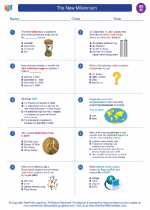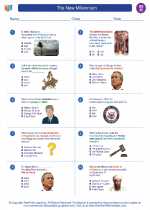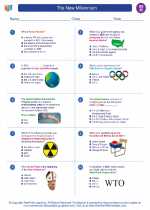The New Millennium
Global conflicts have increased over time and the United States has seen the effects of this in the new millennium. On September 11th, 2001 the World Trade Center and the Pentagon were targets of terrorist attacks. As a result of this, the United States declared a “War on Terror” and has since seen the loss of many American lives. Read More...
◂Social Studies Worksheets and Study Guides Eighth Grade. The New Millennium
Study Guide The New Millennium
The New Millennium  Worksheet/Answer key
Worksheet/Answer key The New Millennium
The New Millennium  Worksheet/Answer key
Worksheet/Answer key The New Millennium
The New Millennium  Worksheet/Answer key
Worksheet/Answer key The New Millennium
The New Millennium 

 Worksheet/Answer key
Worksheet/Answer key
 Worksheet/Answer key
Worksheet/Answer key
 Worksheet/Answer key
Worksheet/Answer key

The resources above cover the following skills:
National Curriculum Standards for Social Studies (NCSS)
TIME, CONTINUITY, AND CHANGE
SOCIAL STUDIES PROGRAMS SHOULD INCLUDE EXPERIENCES THAT PROVIDE FOR THE STUDY OF THE PAST AND ITS LEGACY.
KNOWLEDGE - Learners will understand:
The study of the past provides a representation of the history of communities, nations, and the world.
Concepts such as: chronology, causality, change, conflict, complexity, multiple perspectives, primary and secondary sources, and cause and effect.
That learning about the past requires the interpretation of sources, and that using varied sources provides the potential for a more balanced interpretive record of the past.
That historical interpretations of the same event may differ on the basis of such factors as conflicting evidence from varied sources, national or cultural perspectives, and the point of view of the researcher.
Key historical periods and patterns of change within and across cultures (e.g., the rise and fall of ancient civilizations, the development of technology, the rise of modern nation-states, and the establishment and breakdown of colonial systems).
The contributions of key persons, groups, and events from the past and their influence on the present.
The influences of social, geographic, economic, and cultural factors an the history of local areas, states, nations, and the world.
PEOPLE, PLACES, AND ENVIRONMENTS
SOCIAL STUDIES PROGRAMS SHOULD INCLUDE EXPERIENCES THAT PROVIDE FOR THE STUDY OF PEOPLE, PLACES, AND ENVIRONMENTS.
KNOWLEDGE - Learners will understand:
Human modifications of the environment.
PROCESSES - Learners will be able to:
Evaluate the consequences of human actions in environmental terms.
SCIENCE, TECHNOLOGY, AND SOCIETY
SOCIAL STUDIES PROGRAMS SHOULD INCLUDE EXPERIENCES THAT PROVIDE FOR THE STUDY OF RELATIONSHIPS AMONG SCIENCE, TECHNOLOGY, AND SOCIETY.
KNOWLEDGE - Learners will understand:
Society often turns to science and technology to solve problems.
Science and technology have had both positive and negative impacts upon individuals, societies, and the environment in the past and present.
Science and technology have changed peoples' perceptions of the social and natural world, as well as their relationship to the land, economy and trade, their concept of security, and their major daily activities.
Values, beliefs, and attitudes that have been influenced by new scientific and technological knowledge (e.g., invention of the printing press, conceptions of the universe, applications of atomic energy, and genetic discoveries).
PROCESSES - Learners will be able to:
Ask and find answers to questions about the ways in which science and technology affect peoples' lives today in different places, and have done so in the past.
Seek and evaluate varied perspectives when weighing how specific applications of science and technology have impacted individuals and society.
Review sources to identify the purposes, points of view, biases, and intended audiences of reports and discussions of science and technology.
Select, organize, evaluate, and communicate information about the impact of science or technology on a society today or in the past.
PRODUCTS - Learners demonstrate understanding by:
Discussing current and past issues involving science and technology, and their consequences for society.
GLOBAL CONNECTIONS
SOCIAL STUDIES PROGRAMS SHOULD INCLUDE EXPERIENCES THAT PROVIDE FOR THE STUDY OF GLOBAL CONNECTIONS AND INTERDEPENDENCE.
KNOWLEDGE - Learners will understand:
Spatial relationships that relate to ongoing global issues (e.g., pollution, poverty, disease, and conflict) affect the health and well-being of Earth and its inhabitants.
Global problems and possibilities are not generally caused or developed by any one nation.
PROCESSES - Learners will be able to:
Explore the causes, consequences, and possible solutions related to persistent, current, and emerging global issues, such as health, resource allocation, economic development, and environmental quality.
National Standards for Civics and Government (NSCG)
What are the foundations of the American political system? What is American political culture?
The character of American political conflict. Students should be able to describe the character of American political conflict and explain factors that usually prevent violence or that lower its intensity. To achieve this standard, students should be able to
Describe political conflict in the United States both historically and at present, such as conflict about
Engaging in wars
What is the relationship of the United States to other nations and to world affairs? How is the world organized politically?
Interaction among nation-states. Students should be able to explain how nation-states interact with each other. To achieve this standard, students should be able to
Describe the most important means nation-states use to interact with one another
Diplomacy
United States' relations with other nation-states. Students should be able to explain how United States foreign policy is made and the means by which it is carried out. To achieve this standard, students should be able to
Identify important current foreign policy issues and evaluate the means the United States is using to deal with them
International organizations. Students should be able to explain the role of major international organizations in the world today. To achieve this standard, students should be able to
Describe the purposes and functions of major governmental international organizations, e.g., UN, NATO, OAS, World Court
National Center for History in Schools (NCHS)
Historical Thinking Standards
Chronological Thinking
Identify the temporal structure of a historical narrative or story.
Reconstruct patterns of historical succession and duration; explain historical continuity and change.
Historical Comprehension
Reconstruct the literal meaning of a historical passage.
Identify the central question(s) the historical narrative addresses.
Historical Analysis and Interpretation
Compare and contrast differing sets of ideas.
Analyze cause-and-effect relationships and multiple causation, including the importance of the individual, the influence of ideas.
Draw comparisons across eras and regions in order to define enduring issues.
Challenge arguments of historical inevitability.
Hold interpretations of history as tentative.
Historical Research Capabilities
Formulate historical questions.
Historical Issues-Analysis and Decision-Making
Identify issues and problems in the past.
Identify relevant historical antecedents.
United States History Content Standards
Era 10: Contemporary United States (1968 to the present)
Recent developments in foreign and domestic politics.
The student understands domestic politics in contemporary society.
The student understands major foreign policy initiatives.
World History Content Standards
Era 9: The 20th Century Since 1945: Promises and Paradoxes
The search for community, stability, and peace in an interdependent world.
The student understands how population explosion and environmental change have altered conditions of life around the world.
The student understands major sources of tension and conflict in the contemporary world and efforts that have been made to address them.
Major global trends since World War II.
The student understands major global trends since World War II.